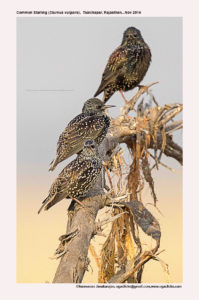
Common Starling Sturnus vulgaris
Etymology :
- Sturnus : Latin word for starlin
- Vulgaris : Latin word for Common derived from vulgus- people
Vernacular Names : Sind: Karo whahio, Chhoto karo whahio, Hindi: Tilyer myna, Kusnai, Tilora, Nakshi tilyer, Kash: Tilgiri, Tsini-hangur, Pun: Tilyar, Ben: Tiley myna, Guj: Kalo vaiyo, Mar: Tilori Myna
Distribution in India: Winter visitor in North and Western part of India
Description: Size of 20-21 cm. In non-breeding plumage it has prominent pale buff to whitish tips on all body feathers, tending to mask gloss of plumage; head is black with purplish-green iridescence; wing and tail are brown with very narrow buff margins, some gloss on outer webs; chin and throat are blackish with some purple gloss ; breast and upper belly are dark brown, glossed green, more purple gloss on flanks; lower belly and undertail coverts lack gloss, have broader and whiter tip. The iris is dark brown; bill is black with brown or grey tinge; legs are reddish-brown to chestnut-brown. The male in breeding season has lost most pale tips, has strong purple gloss on head and throat, green gloss on mantle, rump and breast, feathers of throat and upper breast elongated ,bill yellow, basal third steel-blue, legs deep pink. The female is similar to male, with more extensive pale tips of body feathers and plumage generally less glossy, lanceolate feathers of head and neck shorter and less glossy; iris is dark brown, pale ring on either inner or outer margin variable in colour; during breeding, bill is yellow with paler, pinkish base.
Habitat : It is found in open country, including modified habitats, with access to suitable nesting and roosting sites; requires cavity nest-sites, typically in woodland or on man-made structures, close to open areas of short grassland for foraging. During non-breeding season exploits wide range of habitats, including moorland, saltmarshes, seashore and tidal flats, stubble fields, orchards, refuse dumps and sewage-treatment works. Roosting sites include reedbeds, scrub and trees, also bridges and buildings, even in town centers; huge winter roosts in Europe may contain more than one million birds.
Food Habits: It eats insects like caterpillars, beetles, termites, bees, flies, bugs and earwigs. They also eat seeds & fruit like figs and also nectar. Nestlings are fed mainly with insects, particularly caterpillars and beetles.They are adapted for open-bill probing in grass. Prying technique employed also on seashore, in searching for ectoparasites in fur of mammals, and to expose buried cereal grains. It pursues insects on ground and hawk flying insects. Pulls off fragments of fruit and other large food items. It forages in small to large groups, often in huge flocks in non-breeding season; also singly and in pairs during breeding.
Breeding Habits: They breed in Mar–Jul in Europe.Nest is a bulky structure of dry grass, conifer needles, twigs, string and other material, cup lined with softer material such as grass, feathers, moss, wool, hair and paper, fresh green leaves and flowers often placed in cup by male, built in hole in tree, cliff, building or other structure, exceptionally in hole in ground, or nest placed on ground; generally existing cavity used, including hole excavated by other species such as woodpecker but occasionally will dig own hole in sand dune or soft rock . Competes with other hole-nesting species, and sometimes usurps nest of other species.Shortage of nest-sites can lead to intense intraspecific competition, and fighting can result in death of one of the combatants. They lay a clutch of 4–6 eggs. Incubation is done mostly by female, male doing duty during daytime, male contribution is greater for larger clutches. The incubation period is 11–14 days .The chicks are fed by both parents, when male polygynous one or more females often left to raise brood unaided. The nestling period is 21 days. Young are fed for at least five days after leaving nest. Intraspecific brood parasitism regular at low frequency, and female sometimes removes a host egg when adding her own to a clutch. The female will eject eggs appearing in nest up to day when she lays, and male will do so until 3–4 days before.